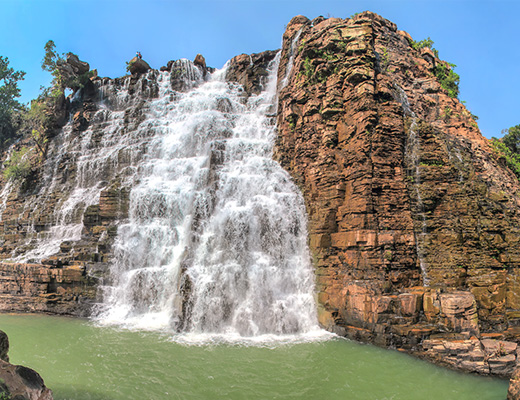INTRODUCTION
Chhattisgarh is in the central part of India. The state shares its border with Madhya Pradesh and Maharashtra in the west, Uttar Pradesh in the north, Odisha and Jharkhand in the east, and Andhra Pradesh and Telangana in the south.
At current prices, Gross State Domestic Product (GSDP) of Chhattisgarh stood at Rs. 3.62 trillion (US$ 51.39 billion) in 2020-21. GSDP (in Rs.) of the state at current prices grew at a CAGR of 9.97% between 2015-16 and 2020-21.
Chhattisgarh is presently one of the few states that have surplus power. Korba district in Chhattisgarh is known as the power capital of India. It is also among the few profitable states in terms of utility-based electricity. As of April 2021, Chhattisgarh had a total installed power-generation capacity of 13,076.27 MW, comprising 8,229.83 MW under private utilities, 1,971.05 MW (state utilities) and 2,875.39 MW (central utilities). Energy requirement in the state was 27,303 million units in 2019-20.
Mineral resources are Chhattisgarh’s biggest strength. It is a leading producer of minerals such as coal, iron ore and dolomite. Moreover, considerable reserves of bauxite, limestone and quartzite are available in the state. The state accounts for 35.4% of tin ore reserves of India. Chhattisgarh is the only state in India that produced tin concentrates.
Chhattisgarh has emerged as one of the most preferred investment destinations in India. The state (including Madhya Pradesh) attracted cumulative Foreign Direct Investment (FDI) worth US$ 1.43 billion between April 2000 and March 2020. Between October 2019 and March 2021, FDI inflow in Chhattisgarh stood at US$ 0.03 million. During 2019, 61 Industrial Entrepreneurs’ Memorandum (IEMs) were filed in Chhattisgarh with a proposed investment of Rs. 5,132 crore (US$ 743.30 million).
Total merchandise exports from Chhattisgarh are estimated at US$ 1,278.69 million in FY20 and US$ 2,320.29 million in FY21.
A wide range of fiscal and policy incentives for businesses were announced under its Industrial Policy, 2014-19. Additionally, the state has well-drafted policies for the IT/ITeS, solar energy, agro and food processing, minerals and biotechnology sectors. Chhattisgarh stands fourth among Indian states in rankings based on ease of doing business and reforms implementation, according to a study by the World Bank and KPMG.
Following completion of the 30-kms Korichhapar-Dharamjaigarh section by IRCON International in January 2021, the complete section of 74 kms between Kharsia and Dharamjaigarh is functional Commencement of this section has made way in evacuating coal from the North Chhattisgarh area Goods train can reach up to Durgapur, and the Baroud and Chhaal mines of Southeastern Coalfields



KEY SECTORS
- Metals and Mining: Chhattisgarh is the only state in India to produce tin concentrates and accounts for 36% of the country’s tin ore reserves. Dante Wada is the sole district producing tin from 6 mines. During 2019-20, tin concentrate production in the state stood at 15,546 kg. Chhattisgarh’s combined export of aluminium and products, iron ore, and iron and steel products reached US$ 1,037.19 million in FY21. Total mineral production in the state during 2019-20 was Rs. 11,125 crore (US$ 1.53 billion). In August 2020, Chhattisgarh accounted for about 13.7% of the total mineral production in India.
- Cement: Chhattisgarh has abundant limestone reserves that support a strong cement sector. Chhattisgarh accounts for around 5.4% of the total limestone reserves in India. Limestone production in the state reached 42.41 million tonnes in 2018-19.
- Agriculture: Around 80% employment in the state is dependent on agriculture. The state’s position as the ‘Rice Bowl of Central India’ and its reliance on agriculture has led to brisk growth in the food processing industry as a special-thrust industry. Non-Basmati rice is the most exported commodity from the state. Its exports reached US$ 257.67 million in FY20 and US$ 474.82 million in FY21. Total horticulture production in the state reached 9,876.16 thousand metric tonnes in 2018-19 with 775.02 thousand hectares of area under cultivation. Between 2011-2012 and 2019-20, the Gross Value Added (GVA) from the primary sector in the state increased at a CAGR (in Rs.) of 9.28 %.
- Apparel: Chhattisgarh is one of the leading producers of tussar and kosa silks in the country and has the potential to be a strong player in the Indian apparel industry. Raw silk production in the state reached 349 metric tonnes in 2018-19 and 480 metric tonnes in 2019-20P.